Arsenic in Groundwater
Arsenic Pollution
Estimated Population at Risk:
750,000
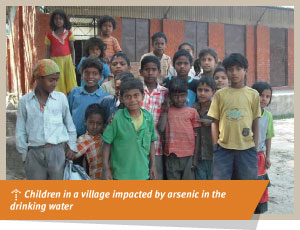 Description
Description
Arsenic is a semi-metallic element – although it is generally referred to as a heavy metal – that occurs naturally in the earth’s crust and has no discernible taste or odor. In its pure, elemental state, arsenic has a grey color and is relatively solid. When arsenic combines with other elements in the environment, it changes to a powder form that is either white or colorless and is very difficult to distinguish. This, along with its lack of smell and taste, makes arsenic compounds in water, air, or on food extremely hard to detect.
Traces of arsenic can be found in air, soil, water, and food. Though naturally occurring arsenic in the soil is usually only found in very low concentrations, some regions of the world contain arsenic-heavy deposits, which have been estimated to tremendously increase arsenic levels in the ground. These arsenic-rich areas have frequently contaminated groundwater supplies, which are often the only source of drinking water for local communities.
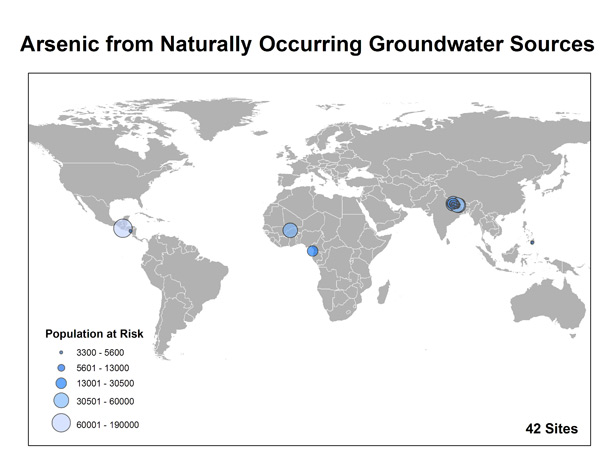
Populations estimates are preliminary and based on an ongoing global assessment of known polluted sites.
Industrial Process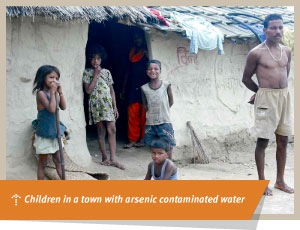 Though there is no specific industrial process that creates this kind of arsenic pollution, the amount of arsenic that leaches from the earth’s crust into groundwater systems can be exasperated by human activity. In many parts of the world, groundwater systems are the only source of water for local communities, and this water is extracted from deep in the earth’s surface using pump wells. Water from these wells is used for a variety of purposes, including irrigation for agricultural fields. Overpumping of water for agriculture has been blamed for pulling higher concentrations of natural arsenic into groundwater systems, which contaminates entire water sources.50
Though there is no specific industrial process that creates this kind of arsenic pollution, the amount of arsenic that leaches from the earth’s crust into groundwater systems can be exasperated by human activity. In many parts of the world, groundwater systems are the only source of water for local communities, and this water is extracted from deep in the earth’s surface using pump wells. Water from these wells is used for a variety of purposes, including irrigation for agricultural fields. Overpumping of water for agriculture has been blamed for pulling higher concentrations of natural arsenic into groundwater systems, which contaminates entire water sources.50

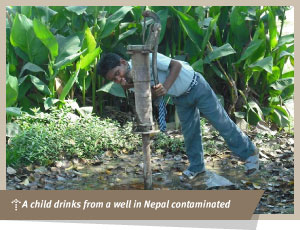 Global Context
Global Context
The areas throughout the world that have the worst documented contamination of groundwater by arsenic are in South Asia, and the toxin poses a frequent problem in Nepal, India, and Bangladesh. According to a report by the WHO, “Bangladesh is grappling with the largest mass poisoning of a population in history” due to arsenic contamination in groundwater, with an estimated 35 to 77 million people at risk.51 Because arsenic contamination in Bangladesh has been the focus of many other agencies, including the WHO, Blacksmith has not completed site assessments for arsenic pollution in this country.
Exposure Pathways
The most common way that people are exposed to arsenic contamination is through ingestion. The arsenic-laden water is often directly used for drinking, but can also contaminate crops when it is used for irrigation purposes.
Health Effects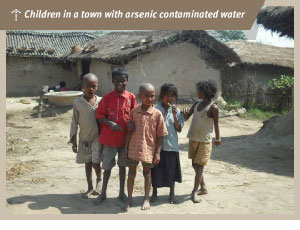 Arsenic is known to be a dangerous toxin that can lead to death when large amounts are ingested. Small amounts of arsenic exposure over long periods of time can also lead to numerous health problems, including abnormal heart beat, damage to blood vessels and a decrease of red and white blood cells, nausea and vomiting, and clearly visible irritations of the skin. A common effect of arsenicosis, or arsenic poisoning, is dark patches of skin, corns, or warts on the body.52
Arsenic is known to be a dangerous toxin that can lead to death when large amounts are ingested. Small amounts of arsenic exposure over long periods of time can also lead to numerous health problems, including abnormal heart beat, damage to blood vessels and a decrease of red and white blood cells, nausea and vomiting, and clearly visible irritations of the skin. A common effect of arsenicosis, or arsenic poisoning, is dark patches of skin, corns, or warts on the body.52
Arsenic is also a documented human carcinogen, and exposure over long periods has been found to cause cancer of the bladder, skin, lungs, kidney, and liver.53
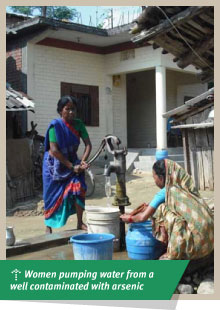 What is Being Done
What is Being Done
Due to the significant and widespread human health problems posed by naturally occurring arsenic in drinking water, much international attention has been paid to this issue, particularly in Bangladesh. Most remediation programs have revolved around identifying and labeling wells with contaminated water, helping communities find safe alternatives for water sources (such as collecting rain water), and implementing low-cost water treatment systems.54
Example – DALY Calculations
A township in the central region of Nepal has high levels of naturally occurring arsenic in the ground that is leaching into the area’s groundwater system. Groundwater is the only source of drinking water in this area, and it is accessed by deep tube wells that bring the water to the surface. Samples of the drinking water in this area found 500 micrograms per liter of arsenic, which is 50 times the health standard. Blacksmith estimates that 8,000 people are at risk of arsenic poisoning in this area.
DALYs associated with health issues caused by arsenic exposure at this site are estimated to be 6,997 for an exposed population of 8,000. The 8,000 affected people will have a collective 6,997 years lost to death, or impacted by disease or disability. This represents 0.9 years lost or lived with a disability per person.
Footnotes:
[50]: "Arsenic Poisoning in India and Bangladesh.” SOS – Arsenic.net. Last updated August 25, 2011. Available at: http://www.sos-arsenic.net/.
[51]: Smith, Allan H., et al. “Contamination of drinking-water by arsenic in Bangladesh: a public health emergency.” Bulletin of the World Health Organization, 2000, 78 (9). Available at: http://www.who.int/water_sanitation_health/dwq/arsenic/en/.
[52]: “ToxFAQs For Arsenic.” Department for Health and Human Services: Agency for Toxic Substances and Disease Registry. August 2007. Available at: http://www.atsdr.cdc.gov/toxfaqs/tf.asp?id=19&tid=3.
[53]: “Water-related diseases: Arsenicosis.” World Health Organization: Water Sanitation and Health. Accessed on September 1, 2011. Available at: http://www.who.int/water_sanitation_health/diseases/arsenicosis/en/.
[54]: “Water-related diseases: Arsenicosis.” World Health Organization: Water Sanitation and Health. Accessed on September 1, 2011. Available at: http://www.who.int/water_sanitation_health/diseases/arsenicosis/en/.

-
Artisanal Gold Mining
Mercury Pollution
-
Industrial Estates
Lead Pollution
-
Agricultural Production
Pesticide Pollution
-
Lead Smelting
Lead Pollution
-
Tannery Operations
Chromium Pollution
-
Mining and Ore Processing
Mercury Pollution
-
Mining and Ore Processing
Lead Pollution
-
Lead-Acid Battery Recycling
Lead Pollution
-
Arsenic in Groundwater
Arsenic Pollution
-
Pesticide Manufacturing and Storage
Pesticide Pollution
-
The Rest of the Toxic Twenty



